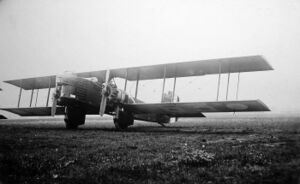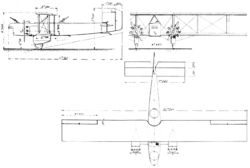Engineering:Lioré et Olivier LeO 20
From HandWiki
| LeO 20 | |
|---|---|

| |
| Lioré et Olivier LeO 20 | |
| Role | night-bomber |
| National origin | France |
| Manufacturer | Lioré et Olivier |
| First flight | 1927 |
| Introduction | 1928 |
| Retired | 1939 |
| Status | retired |
| Primary user | French Air Force |
| Number built | 320[1] |
| Developed from | Lioré et Olivier LeO 122 |
The Lioré et Olivier LeO 20 was a French night-bomber aircraft built by Lioré et Olivier.
Development
The LeO 20 was a development of the LeO 122 prototype. It won the 1926 French ministry competition for a new night-bomber, and received an order for 50 aircraft. The first were delivered at the end of 1926 and flight tested at Villacoublay in 1927. A total of 311 aircraft were delivered to the French air arm, ending in December 1932.[2]
Variants
- LeO 20
- twin-engine night bomber with Gnome-Rhône 9Ady engines (320 built)
- LeO 201
- re-designation for parachute trainers converted from LeO 20
- LeO 203
- four-engine version with Gnome-Rhône 7Kb engines
- LeO H-20/4
- floatplane version of LeO 203
- LeO 206
- production version of LeO 203 with revised nose, ventral "balcony" and tail gun (37 built)
- LeO 207
- similar to LeO 206 but with different nose and smaller "balcony" (3 built)
- LeO 208
- similar to LeO 20 but with enclosed cabin and Gnome-Rhône 14Mrs engines
Operators/Units using this aircraft
 France
France
- French Air Force
- 21st Regiments d'Aviation
- 22nd Regiments d'Aviation
- 12th Regiments d'Aviation
- 34th Regiments d'Aviation
- Aeronautique Militaire School
- French Navy
 Romania
Romania
Specifications (LeO 20)
Data from Jane's all the World's Aircraft 1928,[4][1]
General characteristics
- Crew: 3
- Length: 13.77 m (45 ft 2 in)
- Wingspan: 22.2 m (72 ft 10 in)
- Height: 4.26 m (14 ft 0 in)
- Wing area: 105 m2 (1,130 sq ft)
- Empty weight: 2,580 kg (5,688 lb)
- Gross weight: 5,060 kg (11,155 lb)
- Max takeoff weight: 5,600 kg (12,346 lb)
- Powerplant: 2 × Gnome et Rhône 9Ady Jupiter 9-cylinder air-cooled radial piston engine, 360 kW (480 hp) each
- Propellers: 2-bladed fixed pitch wooden propellers
Performance
- Maximum speed: 196 km/h (122 mph, 106 kn) at sea level
- 189 km/h (117 mph; 102 kn) at 3,000 m (9,800 ft)
- Range: 1,000 km (620 mi, 540 nmi)
- Service ceiling: 5,750 m (18,860 ft)
- Time to altitude: 3,000 m (9,800 ft) in 18.6 minutes
- Wing loading: 48.2 kg/m2 (9.9 lb/sq ft)
- Power/mass: 0.1208 kW/kg (0.0735 hp/lb)
Armament
- Guns: provision for 2x 7.7 mm (0.303 in) machine-guns at nose and dorsal positions and 1x 7.7 mm (0.303 in) machine-gun at ventral position.
- Bombs: 10x 50 kg (110 lb) bombs internally or 7x 70 kg (150 lb) bombs under the centre-section / centre fuselage; maximum 500 kg (1,100 lb)
See also
Related lists
References
- ↑ 1.0 1.1 Sharpe, Michael (2000). Biplanes, Triplanes, and Seaplanes. London: Friedman/Fairfax Books. p. 243. ISBN 1-58663-300-7.
- ↑ Donald, David, ed (1997). The Encyclopedia of World Aircraft. Prospero Books. p. 565. ISBN 1-85605-375-X.
- ↑ Dan Antoniu (2014). Illustrated History of Romanian Aeronautics. p. 89. ISBN 978-973-0-17209-6.
- ↑ Grey, C.G., ed (1928). Jane's all the World's Aircraft 1928. London: Sampson Low, Marston & company, ltd. pp. 107c.
Bibliography
- Hartmann, Gérard. Les Avions Lioré Et Olivier. Boulogne-Billancourt, France: ETAI. 2002. ISBN:2-7268-8607-8 (in French)
 |



